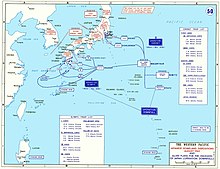
Operation Downfall
Allied plan to invade mainland Japan, WWII / From Wikipedia, the free encyclopedia
Dear Wikiwand AI, let's keep it short by simply answering these key questions:
Can you list the top facts and stats about Operation Downfall?
Summarize this article for a 10 years old
Operation Downfall was the proposed Allied plan for the invasion of the Japanese home islands near the end of World War II. The planned operation was canceled when Japan surrendered following the atomic bombings of Hiroshima and Nagasaki, the Soviet declaration of war, and the invasion of Manchuria.[1] The operation had two parts: Operation Olympic and Operation Coronet. Set to begin in November 1945, Operation Olympic was intended to capture the southern third of the southernmost main Japanese island, Kyūshū, with the recently captured island of Okinawa to be used as a staging area. In early 1946 would come Operation Coronet, the planned invasion of the Kantō Plain, near Tokyo, on the main Japanese island of Honshu. Airbases on Kyūshū captured in Operation Olympic would allow land-based air support for Operation Coronet. If Downfall had taken place, it would have been the largest amphibious operation in history, surpassing D-Day.[2]
| Operation Downfall | |
|---|---|
| Part of the Pacific War | |
 | |
| Location | |
| Planned | Before August 1945 |
| Planned by | |
| Commanded by | Douglas MacArthur |
| Objective | Defeat the Empire of Japan |
| Executed by | See Orders of battle |
| Outcome | Cancelled after the unconditional surrender of Japan on 15 August 1945 |
| Casualties | See estimated casualties |
Japan's geography made this invasion plan obvious to the Japanese as well; they were able to accurately predict the Allied invasion plans and thus adjust their defensive plan, Operation Ketsugō, accordingly. The Japanese planned an all-out defense of Kyūshū, with little left in reserve for any subsequent defense operations. Casualty predictions varied widely, but were extremely high. Depending on the degree to which Japanese civilians would have resisted the invasion, estimates ran up into the millions for Allied casualties.[3]